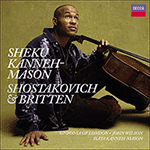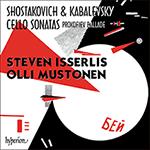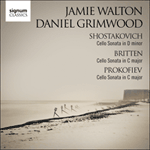
Welcome to Hyperion Records, a British classical label devoted to presenting high-quality recordings of music of all styles and from all periods from the twelfth century to the twenty-first.
Hyperion offers both CDs, and downloads in a number of formats. The site is also available in several languages.
Please use the dropdown buttons to set your preferred options, or use the checkbox to accept the defaults.

Right from the start, the Sonata feels like a new departure. Its gently rocking opening doesn’t sound like anything Shostakovich had written before; the very self-conscious repeat of the sonata exposition is almost a declaration of faith in Classical first principles. And, though Shostakovich had cancelled further lucrative work in film in order to concentrate on it, the Sonata is permeated with the intonations of popular music and Lady Macbeth. Instead of the yearning arioso-writing that can be heard in the contemporaneous Moderato for cello and piano, the Sonata’s Largo shows a stronger kinship with the convicts’ song that concludes the opera, echoing it strongly in its four-bar phrasing, its melodic shape and even at one point by a close allusion. In the cheekily song-like finale Shostakovich reverts to the high spirits of the previous year’s First Piano Concerto, keeping the manic spirit of music-hall only just at arm’s length. Most remarkable of all, though, is the faux-naif second-movement scherzo, with its stark, almost peasant-like roughness. At no point does it evoke Russian folk song; in fact, its heavy repeated rhythms and four-square phrases are more reminiscent of German or Austrian dances as refracted through the lens of Schubert, Brahms or Mahler. Notwithstanding all these influences, there is a distinctly urban swagger to the scherzo, suggesting that here, once again, Shostakovich the film composer is not far away.
from notes by Pauline Fairclough © 2006
D’emblée, la Sonate s’apparente à un nouveau départ. Son ouverture doucement berçante ne ressemble à rien de ce que Chostakovitch a écrit jusque là: la répétition très appuyée de l’exposition de la Sonate sonne presque comme une déclaration de foi dans les grands principes classiques. Et Chostakovitch avait beau avoir annulé de lucratives musiques de films pour se consacrer à elle, cette sonate est imprégnée d’intonations de musique populaire et de Lady Macbeth. À l’écriture arioso languissante du Moderato contemporain pour violoncelle et piano, le Largo de la sonate préfère une parenté avec le chant du forçat qui conclut l’opéra, comme l’attestent son phrasé de quatre mesures, son modèle mélodique et même une allusion directe. Dans le finale effrontément chantant, Chostakovitch retrouve la pétulance du Concerto pour piano no 1 de l’année passée—le fol esprit du music-hall n’est jamais bien loin—, même si le moment le plus remarquable est le scherzo du deuxième mouvement, faussement naïf, avec sa rudesse âpre, presque paysanne, mais sans jamais évoquer les chants populaires russes: en réalité, ses lourds rythmes répétés et ses phrases carrées rappellent plus les danses allemandes ou autrichiennes passées par le prisme de Schubert, de Brahms ou de Mahler. Toutes ces influences n’empêchent pas une fanfaronnade nettement urbaine, preuve que, là encore, le compositeur de musiques de films n’est pas loin.
extrait des notes rédigées par Pauline Fairclough © 2006
Français: Hypérion
Von Anfang an spürt man, dass die Sonate ein neues Kapitel einleitet. Ihre sanft wiegende Einleitung lässt sich mit nichts anderem aus Schostakowitsch’ bisher Komponierten vergleichen. Die sehr selbstbewusste Wiederholung der Sonatenexposition wirkt fast wie ein Glaubensbekenntnis an die Grundprinzipien der Klassik. Obwohl Schostakowitsch mit seiner Ablehnung lukrativer Filmmusikaufträge und seiner Konzentration auf die Sonate anzudeuten schien, dass er ein schwergewichtiges und emotional tiefschürfendes Werk zu komponieren gedachte, hört man im gesamten Werk Anklänge an volkstümliche Musik und den leichteren Ton aus Lady Macbeth. Statt des sehnsuchtsvollen Arioso-Stils, dem man in dem gleichzeitig entstandenen Moderato für Violoncello und Klavier begegnet, weist das Largo der Sonate eine stärkere Ähnlichkeit mit dem die Oper beschließenden Lied der Gefangenen auf. Beiden ist eine viertaktige Phrasierung und gewisse melodische Gestalt gemein, und an einer Stelle spielt das Largo sogar direkt auf das Gefangenenlied an. In dem frech liedhaften Schlusssatz kehrt Schostakowitsch zu der guten Laune aus dem im Jahr zuvor entstandenen 1. Klavierkonzert zurück, wobei er sich der manischen Stimmung eines Varieteetheaters nur mit Mühe enthalten kann. Am bemerkenswertesten ist jedoch der scheinbar naive zweite Satz, ein Scherzo, mit seiner steifen, fast bäuerlichen Ungeschliffenheit. Nirgends klingt es nach russischem Volkslied. Die schwerfälligen wiederholten Rhythmen und vierkantigen Phrasen erinnern eher an deutsche oder österreichische Tänze, gebrochen im musikalischen Prisma eines Schuberts, Brahms oder Mahlers. Trotz dieser Einflüsse zeichnet sich das Scherzo durch einen deutlich städtischen Zug aus, der einmal mehr bezeugt, dass der Filmmusikkomponist Schostakowitsch seine Hand im Spiel hatte.
aus dem Begleittext von Pauline Fairclough © 2006
Deutsch: Elke Hockings
 Shostakovich & Britten: Cello Concerto & Sonatas Shostakovich & Britten: Cello Concerto & SonatasKanneh-Mason’s debut recording on Decca was entitled ‘Inspiration’ and at its centre was Shostakovich’s mighty Cello Concerto No 1. Seven years on, this remarkable young cellist returns with the composer’s second concerto, recorded during an accla ...» More |
 Shostakovich & Kabalevsky: Cello Sonatas Shostakovich & Kabalevsky: Cello SonatasA troika of Russian greats: masterpieces and makeweights from Shostakovich, Prokofiev and Kabalevsky. Steven Isserlis and Olli Mustonen navigate the unsettling ambiguities of this music with unerring precision.» More |
 Shostakovich, Britten & Prokofiev: Cello Sonatas Shostakovich, Britten & Prokofiev: Cello SonatasThe authentic musical complicity between Jamie Walton and Daniel Grimwood for having performed and worked together regularelym lead to the present album featuring sonatas for cello and piano by Shostakovich, Britten and Prokofiev.» More |

